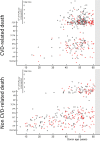Qualitative evaluation of coronary atherosclerosis in a large cohort of young and middle-aged Dutch tissue donors implies that coronary thrombo-embolic manifestations are stochastic
- PMID: 30481212
- PMCID: PMC6258539
- DOI: 10.1371/journal.pone.0207943
Qualitative evaluation of coronary atherosclerosis in a large cohort of young and middle-aged Dutch tissue donors implies that coronary thrombo-embolic manifestations are stochastic
Abstract
Background and aims: With the intention to gain support for the hypothesis that incident ischemic complications of atherosclerotic disease involve a stochastic aspect, we performed a histological, qualitative evaluation of the epidemiology of coronary atherosclerotic disease in a cohort of aortic valve donors.
Patients and methods: Donors (n = 695, median age 54, range 11-65 years) were dichotomized into a non-cardiovascular (non-CVD) and a cardiovascular disease death (CVD) group. Consecutive 5 mm proximal left coronary artery segments were Movat stained, and the atherosclerotic burden for each segment was graded (revised AHA-classification).
Results: Non-CVD and CVD groups showed steep increase of atherosclerosis severity beyond the age of 40, resulting in an endemic presence of advanced atherosclerosis in men over 40 and women over 50 years. In fact, only 19% of the non-CVD and 6% of the CVD donors over 40 years were classified with a normal LCA or a so called non-progressive lesion type. Fibrous calcified plaques (FCP), the consolidated remnants of earlier ruptured lesions, dominated in both non-CVD and CVD donors. Estimates of the atherosclerosis burden (i.e. average lesion grade, proportion of FCPs, and average number of FCPs per cross-section) were all higher in the CVD group (p<1.10-16, p<0.0001, and p<0.05, respectively).
Conclusions: Dominance of consolidated FCP lesions in males over 40 and females over 50 years, show that plaque ruptures in the left coronary artery are common. However, the majority of these ruptures remain asymptomatic. This implies that the atherosclerotic process is repetitive. A relative difference in disease burden between CVD and non-CVD donors supports the concept that complications of atherosclerotic disease involve a stochastic element.
Conflict of interest statement
The authors have declared that no competing interests exist.
Figures



Similar articles
-
Accelerated coronary atherosclerosis not explained by traditional risk factors in 13% of young individuals.Am Heart J. 2019 Feb;208:47-54. doi: 10.1016/j.ahj.2018.11.005. Epub 2018 Nov 13. Am Heart J. 2019. PMID: 30544071
-
Atherosclerosis in intracranial, extracranial, and coronary arteries with aortic plaques in patients with ischemic stroke of undetermined etiology.Int J Neurosci. 2015;125(9):663-70. doi: 10.3109/00207454.2014.961188. Epub 2014 Sep 30. Int J Neurosci. 2015. PMID: 25180988
-
In-situ analysis of mast cells and dendritic cells in coronary atherosclerosis in chronic kidney disease (CKD).Histol Histopathol. 2018 Aug;33(8):871-886. doi: 10.14670/HH-11-988. Epub 2018 Apr 4. Histol Histopathol. 2018. PMID: 29616745
-
Preeclampsia and coronary plaque erosion: Manifestations of endothelial dysfunction resulting in cardiovascular events in women.Eur J Pharmacol. 2017 Dec 5;816:129-137. doi: 10.1016/j.ejphar.2017.09.012. Epub 2017 Sep 9. Eur J Pharmacol. 2017. PMID: 28899695 Review.
-
Sex Differences and Emerging New Risk Factors for Atherosclerosis and Its Thrombotic Complications.Curr Pharm Des. 2021 Sep 23;27(29):3186-3197. doi: 10.2174/1381612826666201118094209. Curr Pharm Des. 2021. PMID: 33213315 Review.
Cited by
-
Extraction of Coronary Atherosclerotic Plaques From Computed Tomography Imaging: A Review of Recent Methods.Front Cardiovasc Med. 2021 Feb 10;8:597568. doi: 10.3389/fcvm.2021.597568. eCollection 2021. Front Cardiovasc Med. 2021. PMID: 33644127 Free PMC article. Review.
-
Validating human and mouse tissues commonly used in atherosclerosis research with coronary and aortic reference tissue: similarities but profound differences in disease initiation and plaque stability.JVS Vasc Sci. 2023 Jul 11;4:100118. doi: 10.1016/j.jvssci.2023.100118. eCollection 2023. JVS Vasc Sci. 2023. PMID: 37810738 Free PMC article.
References
-
- GBD 2016 DALYs and HALE Collaborators. Global, regional, and national disability-adjusted life-years (DALYs) for 333 diseases and injuries and healthy life expectancy (HALE) for 195 countries and territories, 1990–2016: a systematic analysis for the Global Burden of Disease Study 2016. Lancet. 2017; 390: 1260–1344. 10.1016/S0140-6736(17)32130-X - DOI - PMC - PubMed
-
- Libby P. The Forgotten Majority: Unfinished Business in Cardiovascular Risk Reduction. J Am Coll Cardiol 2005; 46: 1225–1228 10.1016/j.jacc.2005.07.006 - DOI - PubMed
-
- Piepoli MF, Hoes AW, Agewall S, Albus C, Brotons C, Catapano AL, et al. 2016 European Guidelines on cardiovascular disease prevention in clinical practice: The Sixth Joint Task Force of the European Society of Cardiology and Other Societies on Cardiovascular Disease Prevention in Clinical Practice (constituted by representatives of 10 societies and by invited experts)Developed with the special contribution of the European Association for Cardiovascular Prevention & Rehabilitation (EACPR). Eur Heart J. 2016; 37: 2315–81. 10.1093/eurheartj/ehw106 - DOI - PMC - PubMed
-
- Wong ND. Epidemiological studies of CHD and the evolution of preventive cardiology. Nat Rev Cardiol. 2014; 11: 276–89. 10.1038/nrcardio.2014.26 - DOI - PubMed
-
- Coggon DI, Martyn CN. Time and chance: the stochastic nature of disease causation. Lancet. 2005; 365: 1434–7. 10.1016/S0140-6736(05)66380-5 - DOI - PubMed
Publication types
MeSH terms
LinkOut - more resources
Full Text Sources
Medical
Molecular Biology Databases
Research Materials

